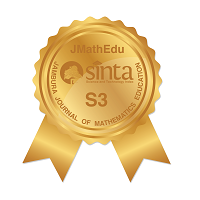Author Guidelines
Manuscript Submission
Jambura Journal of Mathematics Education (JMathEdu) is a national journal intended as a communication forum for mathematicians and other scientists from many practitioners who use mathematics in the research. JMathEdu received a manuscript in areas of study mathematics, applied mathematics, statistics, applied statistics, and mathematics of education. Manuscripts should be submitted online http://ejurnal.ung.ac.id/index.php/jmathedu/about/submissions. It is understood that the submitted paper is not being considered for publication in other journals. If a paper is accepted for publication in our journal, the author is assumed to have transferred the copyright to the Jambura Journals of Mathematics. All articles for this journal must be submitted using our online submissions system.
Reviewing of Manuscripts
Each received paper will be sent to at least two reviewers for evaluation. We use the double-blind peer-review process. The decision is made based on the evaluation reports from the reviewers. Whenever necessary, we ask a third reviewer to evaluate the paper.
Abstract Indexing
Articles published in Jambura Journal of Mathematics Education have appeared in the following indexed:
Form of Manuscript
The paper should be written in Bahasa Indonesia or English. Manuscripts should be prepared by using the provided template on MS Word which can be downloaded from our website). Make sure that your paper has abstract, keywords and phrases, and the current Mathematics Subject Classification (MSC). Avoid complicated formulas in the title as well as in the abstract.
IMPORTANT: Since the manuscript undergoes a double-blind review process, all author(s) personal information should be removed and excluded from the main document as well as file names. Please make sure the following are not included in your manuscript: names, acknowledgments, university information, contact information, etc. You would be able to add all this information later if your manuscript is accepted for publication.
Abstract
The abstract must be presented in English and Indonesian. It should summarize the main result(s) and, possibly, the method(s) used, in at most 200 words. If the paper is a survey paper, it must be indicated so in the abstract. For authors from outside Indonesia, the Indonesian abstract will be translated from the English abstract by the Editor.
Figures
If any, figures should be supplied in a form suitable for photographic reproduction after the printer has inserted any necessary lettering in the correct type. They should be printed or drawn in black ink on good white paper, at approximately the size that they will be printed.
References
The reference at the end of the text must be written by the following example. Quote only the items that you have read. It is recommended to use Manager Reference Applications such as EndNote, Mendeley, Zotero, etc. Use other articles published in the same journal as the model. All publications cited in the text must be included as a list of Bibliographies with the IEEE Style. Examples of citations and reference writing for journal articles can be seen in [1] [2] [3], reference types of proceedings seen in [4] [5], reference type/ thesis/ dissertation seen in [6] [7] [8 ] Furthermore, reference to the type of book is seen in [9] and references in the form of websites are seen in [10]. Meanwhile [11] shows examples of citations and reference writing in the form of articles in the book (Book Section).
[1] R. Resmawan, P. Sianturi, and E. H. Nugrahani, “The Analysis of SEIRS-SEI Epidemic Models on Malaria with Regard to Human Recovery Rate,†Aceh Int. J. Sci. Technol., vol. 6, no. 3, pp. 132–140, Mar. 2018.
[2] S. Ding, “A novel discrete grey multivariable model and its application in forecasting the output value of China’s high-tech industries,†Comput. Ind. Eng., vol. 127, pp. 749–760, 2019.
[3] S. Ismail and M. Bakari, “Meningkatkan Penguasaan Siswa Kelas IX pada Fungsi Kuadrat dan Grafiknya Menggunakan Teknik Inkuiri,†Jambura J. Math., vol. 1, no. 1, 2019.
[4] R. Resmawan, “Model Epidemik SEIRS-SEI Penyebaran Penyakit Malaria dengan Vaksinasi dan Pengobatan,†in Prosiding Seminar Nasional Matematika IndoMS Wilayah Sulawesi, 2017, pp. 128–140.
[5] B. N. Ruchjana, S. A. Borovkova, and H. P. Lopuhaa, “Least-squares estimation of Generalized Space-Time AutoRegressive (GSTAR) model and its properties,†in The 5th International Conferences on Research and Education in Mathematics, 2012, pp. 61–64.
[6] S. O. S. P. Ahaya, “Analisis Kestabilan Model Epidemik dengan Vaksinasi pada Penyakit Campak,†Universitas Negeri Gorontalo, 2019.
[7] D. Wungguli, B. P. Silalahi, and S. Guritman, “Metode Steepest Descent dengan Ukuran Langkah Baru dalam Pengoptimuman Nirkendala,†Institut Pertanian Bogor, Bogor, 2015.
[8] A. Thiele, “A robust optimization approach to supply chains and revenue management,†Massachusetts Institute of Technology, 2004.
[9] A. Rorres, An Introduction to Linear Algebra, 4 Edition. London: Pearson, 2017.
[10] U. S. G. Survey, “Science Application for Risk Reduction,†2018. [Online]. Available: https://www.usgs.gov/natural-hazards/science-application-risk-reduction. [Accessed: 15-Oct-2018].
[11] P. van den Driessche and J. Watmough, “Further Notes on the Basic Reproduction Number,†in Mathematical Epidemiology, Victoria: Springer, 1945.























